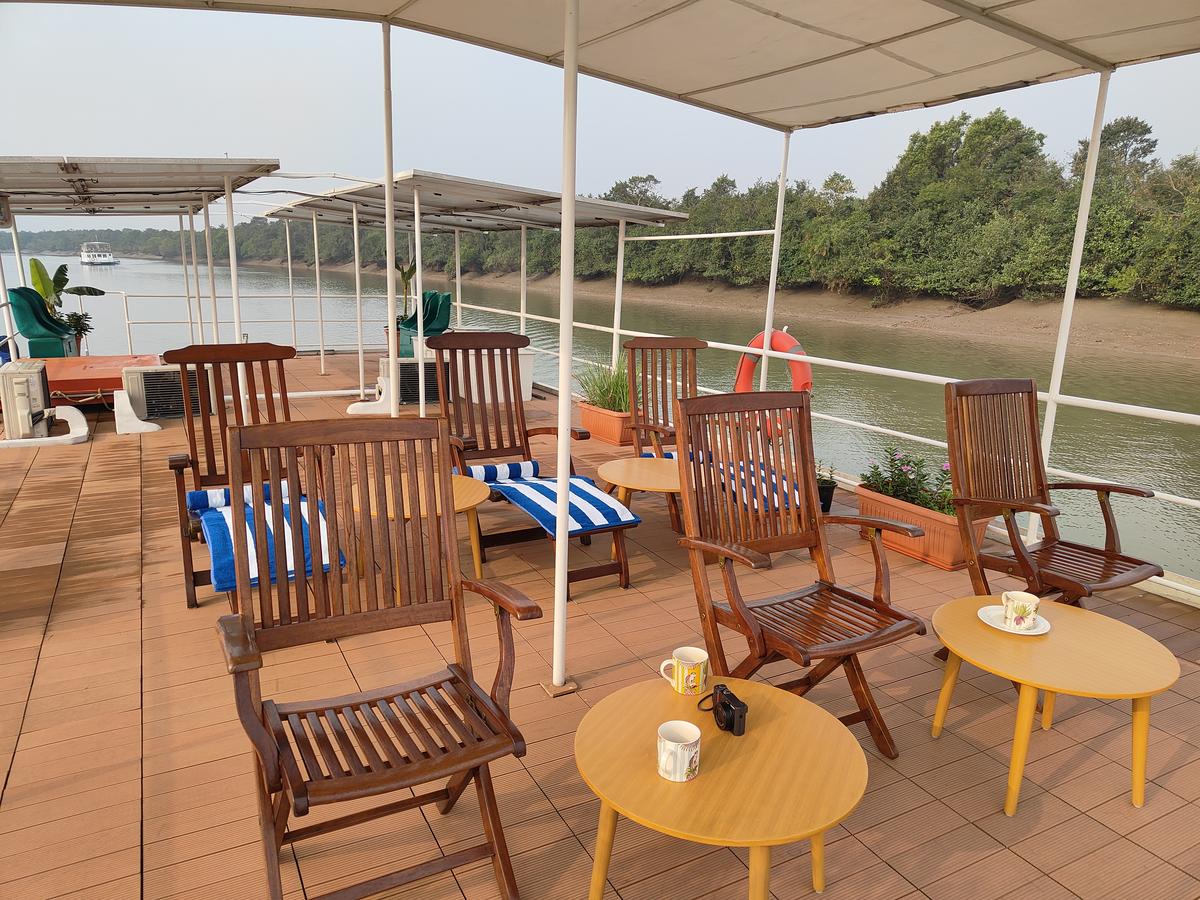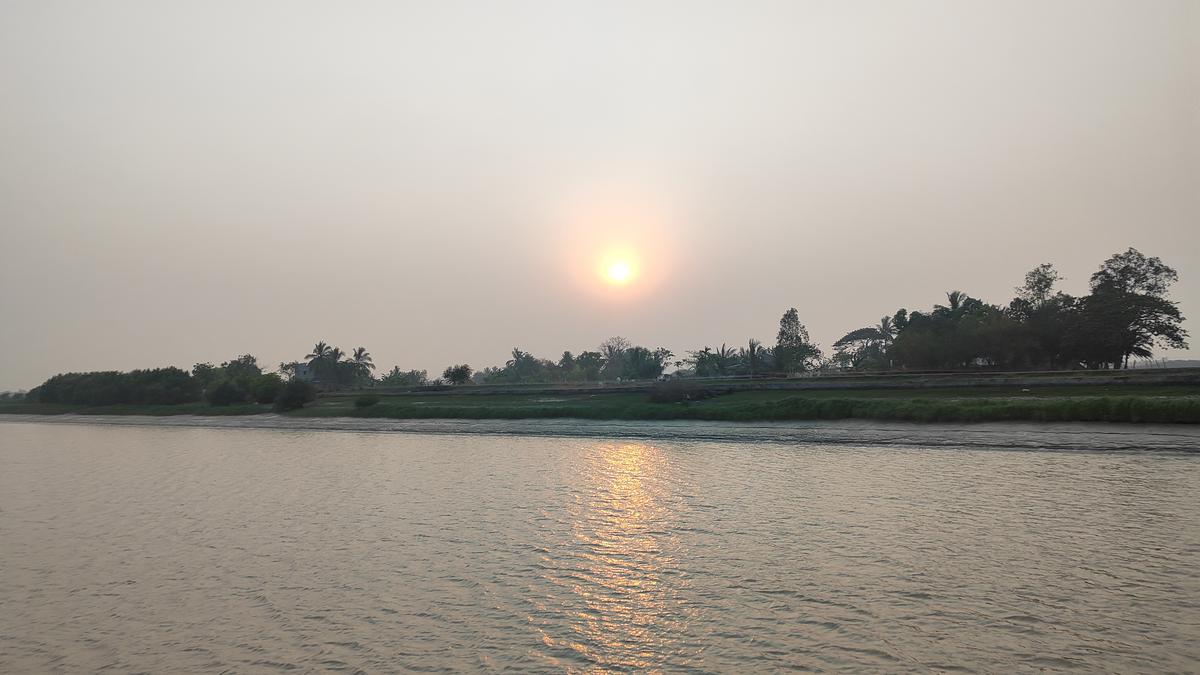As we settle down comfortably on the sun deck of our luxury catamaran, the MV Brahmani, we hear the shouts of the boat captain from down below. “Crocodile! Crocodile relaxing!” He almost sounds too jubilant for having spotted the mostly terror-inducing, yet fascinating reptile. We look out over the waters on our right and sure enough, spot our first crocodile. Much like us, the crocodile is sunning itself on the muddy banks of the river.
Saltwater crocodiles can be seen sunning themselves on mudflats
| Photo Credit:
Special Arrangement
The second largest mangrove system in India after the Sunderbans, the Bhitarkanika National Park, Odisha is home to many crocodiles in the creeks and estuaries of the Brahmani-Baitarani river systems, as well as migratory birds, and a host of other flora and fauna. While the park is accessible by road, we are exploring the region by water — on a luxury catamaran by Antara River Cruises.
The vessels come fully furnished with two bedrooms, bathrooms and a dining space in front, in addition to the sun deck furnished with comfortable chairs. The boats are best suited for groups of four (priced at ₹25,000 per person for two nights inclusive of meals) who can be accomodated in the two bedrooms. Locals from the area staff the fleet of four catamarans, and are only too pleased to chat about their favourite crocodile sightings. “There is one 23-foot crocodile that goes for a long morning swim. I hope all of you get to see it,” one of them cheerily informs us.
Declared a Ramsar site (a wetland of national importance) in 2002, we learn that there are around 1,700 saltwater crocodiles that were counted in the last census which took place in January 2024. The dense mangrove here comprises 82 species and host birds through the year which include purple herons, night herons, pied harriers, grey-headed lapwings, eagles and owls.
Spotted deer are a common sighting at the national park
| Photo Credit:
Special Arrangement
“There is something here for everyone,” says Sanghamitra Jena, who manages operations. “Whether you are here to birdwatch and take pictures, explore the wildlife, walk through the forests, or simply laze around on the catamaran and enjoy setting sail,” she says. As we take in the calm waters and orange hued skies at sunset, we remain alert, for sightings of more crocodiles on the mudflats. We also spot herds of spotted deer frolicking by the banks, while also keeping an eye out for possible otter and dolphin sightings.
When the catamaran finally anchors for the night, we are immensely thankful for two things — the air conditioning onboard given the sweltering early summer heat, and bhetki fish on the menu for dinner. Bhetki, which is barramundi or Asian sea bass, is a popular fixture on the menu and all meals onboard feature fresh catch and local delicacies, including the popular Odisha dessert chennapooda. Three meals are served onboard, at a cosy dining space in front of the rooms and the menu has the usual favourites — eggs, toast, poha, parathas for breakfast, roti, subzi, meat and vegetables for lunch as well as continental options such as grilled fish and mashed potatoes.

The sundeck on the luxury catamaran
| Photo Credit:
S Poorvaja
The prospect of spotting more crocodiles has us cautiously excited the following day, as we set sail and anchor near the entrance of the Bhitarkanika National Park which houses the Crocodile Hatchery and Rearing Programme.
It is here that we truly get to experience the thick of it all; walking directly into the mangrove forest by navigating a wooden bridge that has been built to act as a living observatory deck. We hear bird calls, keep looking up at the mangrove canopy above us, and clutch the railings every time we take a look at what lies below. Unfortunately, the crocodiles remain elusive; none of them has ventured out to see a party of 10 cautiously walk overhead.

At our destination however, there are a number of baby crocodiles in enclosures, swimming happily or sunning themselves. The Saltwater Crocodile Research and Conservation Project was established at Dangmal with the objective of rearing and releasing crocodiles into the wild, and there are separate enclosures showing the life-cycle of a crocodile from the hatching stage. The park is also home to a rare albino crocodile, named Gori, and we learn that efforts to mate her have proven to be futile. Gori now lives by herself in an enclosure, an independent queen.

The dense mangrove at Bhitarkanika
| Photo Credit:
Special Arrangement
With many little creeks and estuaries, we go on to explore the mangrove system in a smaller boat, through a slow, two-hour journey. Armed with binoculars, we spot birds in the branches of trees, and much to our delight, manage to catch sight of a baby crocodile peacefully sunning itself on a small branch, before gracefully turning over and falling straight into the water with a little splash.
The catamarans see a bulk of their tourist guests between October and February. “From May 1 to the end of July, the park is closed because that is the time the crocodiles typically breed. We see an influx of birdwatchers and wildlife enthusiasts start coming in during August and later,” Sanghamitra says, as she guides us back to our catamarans. After a day of exploring the mangroves in the searing heat and unabating humidity, we thankfully take the shikanji, a cold lemon flavoured drink we are welcomed back onboard with.
Afternoons during the cruise are best spent in the cool confines of the cabin, on the sun deck, or for the more adventurous travellers, a jungle walk at Shikhar Kothi, where a canopy of leaves and branches is a welcome shield from the heat. We are told that spotting snakes including pythons are quite common in the area.
When the catamaran once again sets sail during sunset, the views do not feel repetitive or tiresome. There is a calmness that settles on the water as the skies turn orange and then a slow inky blue. We once again keep our eyes trained on the mudflats, often pausing to admire the smaller creeks and channels that we sail by. This languorous cruise is best enjoyed on the sun deck, binoculars in one hand for croc-spotting, and a plate of evening pakodas and tea in the other.
The writer was at the Antara River Cruises, Bhitarkanika on invitation from RARE India
Published – April 25, 2025 05:21 pm IST

